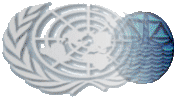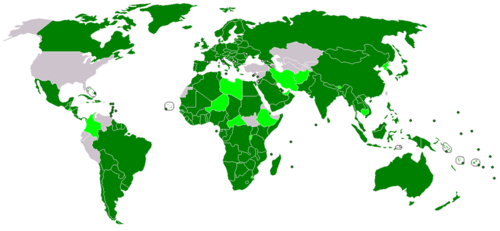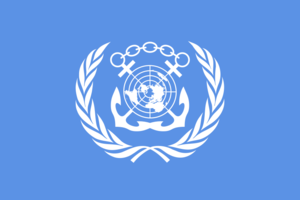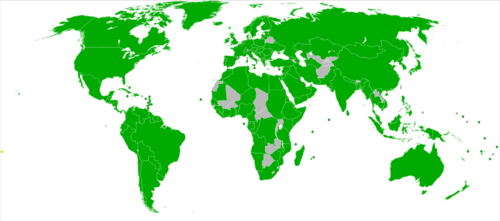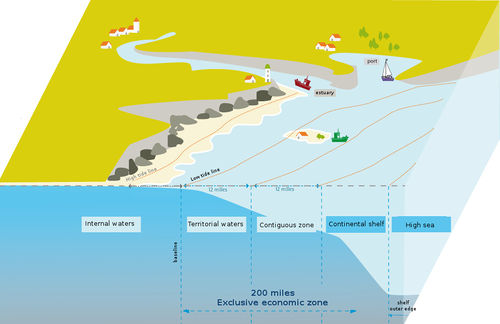UN Convention on the Law of the Sea
Definition of UN Convention on the Law of the Sea:
This Convention lays down the general obligations of states to protect and preserve the marine environment. The United Nations Convention on the Law of the Sea (UNCLOS) was adopted in 1982.
This is the common definition for UN Convention on the Law of the Sea, other definitions can be discussed in the article
|
The legislation for the sea is the set of laws and international agreements related to the use of the sea, defined as freely and naturally connected expanses of salt water, by the different countries and business. Since sea has always represented a wealth of natural resources as well as highly strategic military positions being in the center of geopolitical stakes, regulations about its use have been established for ages and the corpus of laws is now covering a lot of different topics.
Contents
History
The legislation for the sea is mostly inherited from traditions. It is one of the oldest branch of public international law. The main principle defining it in peaceful times is the principle of freedom which was laid for the first time by the Dutch lawyer Grotius in the XVIIth century, in its book “De jure praedae” (on the law of prize and booty) and especially one of the chapter “Mare Liberum” [1](free sea) published in 1609. There the founder of public international law defended the idea that the sea could not be claimed by anyone contrary to terrestrial areas which are the only territories that can be occupied by a nation. The book was written upon request of the Dutch East India company, which wanted to establish a legal framework allowing it to capture enemy ships.
The principle of freedom means that every nation can freely use the sea as they wish. It is under the influence of this text that countries gradually gave up their claims on national sovereignty of maritime areas. From the XVIIIth century, the legislation for the sea started to distinguish between a part of the sea next to the territory of the states and the deep sea, following the idea enunciated in 1702 by Cornelius van Bijnkershoek – another Dutch jurist – in “De Dominio Maris Dissertatio”[2]. In this treaty, van Bijnkershoek developed Grotius idea that coastal states have a right to the adjoining waters as long as they are able to exercise an effective control over it. The width of this coastal area was estimated as “terrae potestas finitur ubi finitur armorum vis”, or the range of coastal weapons. The range of canonballs was then about 3 nautical miles or 5.5 kilometers. Within this distance from the coast, the neighbouring state could claim its full sovereignty. On the contrary, deep sea could still not be claimed by any nation. This new law also let countries resist Great Britain’s strategy of stopping trading between its enemies and the rest of the world thanks to its maritime supremacy.
In 1856, the principle of freedom was once again repeated by the declaration of Paris which was first signed by the two most powerful maritime countries of that time, Great Britain and France, then followed by other nations. However it was felt that the legislation was still not sufficient since there was no provision for the case of sea wars. The two world wars confirmed the need for such provisions and this was one of the main tasks of the United nations just after its creation in 1945. To strengthen the legal framework of the sea, a conference was organized in Geneva in 1958. There, the participating states agreed on four treaties two of which are still in force today. Those four treaties deal with rights and duties of states regarding territorial sea, deep sea, fishing and conservation of living resources.
In spite of this very important first step that leaded to a first codification of the legislation for the sea, the nations could not agree on the boundaries of the sea areas under national sovereignty. Conflicts between nations went on until a new conference of the United Nations in 1982 that finally reached a consensus. During the 1960’s, the progress towards an agreement was slowed down by countries of the third-world. They feared that international conventions would deprive them of natural resources, fish and oil which exploitation was not at their reach at that time because it required enormous financial investments. Those countries then requested a large extension of their sovereign sea areas in order to prevent other states from exploiting natural resources in those areas. At the same time, the technological progress accomplished for fishing in deep sea, mining, offshore oil extraction and the ever-increasing risks of human activities for the natural environment led to a multiplication of territorial claiming, mostly rival, and even unilateral decisions to limit the rights to fish and sail.
The convention of Montego Bay was finally adopted in 1982 after a lot of negociations and came into force in 1994. This international agreement is today the main corpus of legislation for the sea.
Founding texts and authorities
United Nations convention on the law of the sea
1956 – 1958: first conference
After some years work on codification of public international law, the United Nations held their first conference on the topic of the law of the sea between 1956 and 1958 in Geneva (Switzerland). Four conventions are adopted:
- the convention on the territorial sea and contiguous zone, which comes into force in 1964;
- the convention on the high seas, which comes into force in 1964;
- the convention on the continental shelf, which comes into force in 1962 and defines the boundaries of the continental shelf as well as the rights of the nations to explore and exploit the natural resources in it;
- the convention on fishing and conservation of living resources of the high seas, which comes into force in 1966.
This convention was considered as a success at that time although it failed to define proper boundaries of nation’s sovereign areas. A new conference in 1960 was held but resulted in no new agreements in a time of cold war and major divisions in the world.
1973 – 1982: third conference
The third conference is held by the United nations when countries of the third-world challenge some of the rules adopted in Geneva. 160 countries take part in the process. It lasts from 1973 to 1982 and results in the signature in Montego Bay of the United Nations Convention on the Law of the Sea (UNCLOS)[3]. The convention defines more accurately some of the concepts that were used in traditional law, like the territorial sea, the exclusive economic zone, the continental shelf and adds new ones like archipelagic waters, navigable straits, seabed.
The convention came into force on November 16th, 1994. However some countries who signed it have not ratified it yet, and most notably the United States who agree with the whole convention except part XI providing a regime for the exploration and mining of minerals from the seabed outside exclusive economic areas. One of the reasons that made it so long for countries to sign and ratify the treaty was one of the articles that prevented them from taking out any reservation to any part of the treaty. The treaty had to be adopted as a whole or not at all.
This convention, with its 320 articles and 9 appendix that address lots of topics, is one of the most important international agreement in human history.
Controlling authorities
UNCLOS also established two new international institutions to control the use of the maritime territory and settle disagreements between countries.
The International tribunal for the law of the sea, based in Hamburg (Germany), is an independent intergovernmental organization is responsible for settling disputes between countries who signed the treaty. It is made up of 21 judges elected by the state parties. It has jurisdiction over any dispute concerning the interpretation or application of the Convention, and over all matters specifically provided for in any other agreement which confers jurisdiction on the Tribunal. Disputes relating to the Convention may concern the delimitation of maritime zones, navigation, conservation and management of the living resources of the sea, protection and preservation of the marine environment and marine scientific research.
The International seabed authority (ISA) is a special organism established to control the activities of mining minerals in the international seabed as defined by UNCLOS and therefore beyond the limits of national jurisdiction. It has been created in 1994, although its assignments are defined in the conference in 1982. ISA is committed to protect the seabed for the shared benefit of humankind and to the principle that all nations should benefit from responsible, sustainable and regulated economic activities in the deep seabed, including deep-sea mining and from the potential resources the deep sea holds for a global green transition. ISA works to ensure that the voices of all States and stakeholders, including developing States, civil society organizations and all ISA Member States, are effectively heard in discussions around the sustainable development of the deep seabed.
The International Maritime Organization: the long arm of UNCLOS
The International Maritime Organization (IMO), previously called the Intergovernmental maritime consultative organization, was established in Geneva in 1948 as a specialized agency of the United Nations and met for the first time in 1959. Its role is to develop a legal regulatory framework for shipping accepted by all maritime countries.
The four main tasks of the IMO are:
- to make member states collaborate in maritime regulation,
- to make member states adopt safety norms,
- to avoid maritime pollutions by ships and harbours,
- to convince member states to drop discriminatory measures against the use of maritime services by foreign ships.
In 2012, the IMO has 170 member states and 3 associated states. The organization works by preparing technical specifications of legal texts and making the assembly adopt them. The assembly is made of representatives of every member state and it is held every two years.
Among the most important pieces of work of the organization, the Safety of Life at Sea convention[4], which first version dated from 1914, was updated shortly after its creation in 1960 and then once again in 1974. It is often regarded as the most important of all international treaties about the safety of trading ships. More recently, the IMO enacted a Port state control authority to allow local maritime authorities to inspect foreign ships and published the International Ship and Port facility Security code[5] to improve the protection of harbours and ships against piracy and terrorism.
Regulations proposed by IMO must be enforced by national and local authorities in member states.
Special international treaties
Through the work of IMO, a number of international conventions adds up to the legislation for the sea. Some of the most notable ones are the following:
- International convention for the safety of life at sea (SOLAS). The first version was prepared in 1914 after the sinking of the Titanic. It was made to make it mandatory for ships to have sufficient numbers of lifeboats and emergency equipment. It also prescribed safety procedures. This first version was extended during the XXth century. In its last version, SOLAS requires flag states to ensure their ships comply with safety standards in design, equipment and operation. It also has provisions for radiocommunications, stowage of cargoes and the minimal crew to operate the ship. One of its latest amendment is the International Ship and Port facility Security code which establishes minimum security procedures for ships and ports and make them take preventive measures against terrorism or other security incidents affecting ships and ports.
- International regulations for Preventing Collisions at Sea (COLREG).[6] This convention signed in 1972 describes navigation rules that ships have to comply with in order to avoid collisions with other vessels. Rules cover a large scope of fields: sailing and steering, lights and shapes, sound and light signals, depending also on the external visibility.
- International convention for the Prevention of Pollution from Ships (MARPOL).[7] The convention was prepared in 1973 and modified in 1978. It is the main environmental convention, designed to minimize pollution of seas. Its objective is to fully eliminate the continuous sources of pollution from oil and other harmful elements and limit the risk of accidental releases.
- International convention on maritime Search and Rescue (SAR). This agreement was established in 1979 and came into force in 1985. Signing parties must set up instruments and technologies to facilitate the searching of ships and persons in distress at sea, and rescue them when needed.
Main principles of the legislation
The United Nations convention on the law of the sea clearly distinguishes between different areas in the sea. The old distinction between coastal zone where countries could claim their sovereignty and high seas where the general rule was that of freedom still exists, but an agreement was finally reached for the accurate definition of those zones. The geographic boundary of those areas is determined with respect to the distance to the coast. Each country is free to draw its own baseline in a reasonable way to define its coast. This baseline is either the line reached by the sea during the lowest tides when the coast is quite regular, or geometric straight lines linking capes when the coast is very ragged. From the coast to the high seas, the main areas are internal waters, territorial waters, the continental shelf and the high sea.
Internal waters are made of the areas between the baseline and the coast. It includes ports, internal seas and havens. The subsoil and the aerial space below and above those areas belong to it. Those areas are considered as a part of the terrestrial territory of the neighbour state according to the second article of the convention of Montego Bay. So the state has the full sovereignty over them.
Territorial waters are made of the maritime space adjoining internal waters. They can extend to 12 nautical miles of the baseline. In those areas, the neighbouring state is still sovereign and can freely use any resource. It can also set laws regarding fishing, mining minerals, navigation, public safety, protection of the environment and customs. However, foreign vessels have a right of innocent passage through them, that is they can pass through waters in a continuous manner if they do not carry out activities prejudicial to the peace and good order. Beyond the territorial waters, there is another 12-miles wide area where states can continue to enforce laws in four specific fields: customs, taxation, immigration and pollution if the infringement started within their territory.
From a geological point of view, continental shelf is the plateau around continents where the seabed slowly goes down until the depth reaches 200 meters. This zone goes beyond territorial waters. Each state is responsible for locating the boundary of the continental shelf, in accordance with advices of the international commission for the continental shelf. The juridic continental shelf extends to at least 200 nautical miles from the baseline, up to a maximum of 350 miles. The neighbouring state can mine minerals and materials in this area to the exclusion of foreign countries. It also has exclusive control over living resources attached to the shelf.
The exclusive economic zone extends from territorial waters to a line located 200 miles from the baseline. An exception occurs when two zones would overlap. In this case, it is up to the neighbouring states to agree on the boundary, or by default choose the middle line between their own baselines. In those areas, states can make use of sovereign rights for exploration, exploitation and management of living and non-living resources. As the convention gives state an exclusive right to use resources from the exclusive economic zones, they have today a high political and economical importance. As a result, there are still disputes between some countries about the limit of their EEZ.
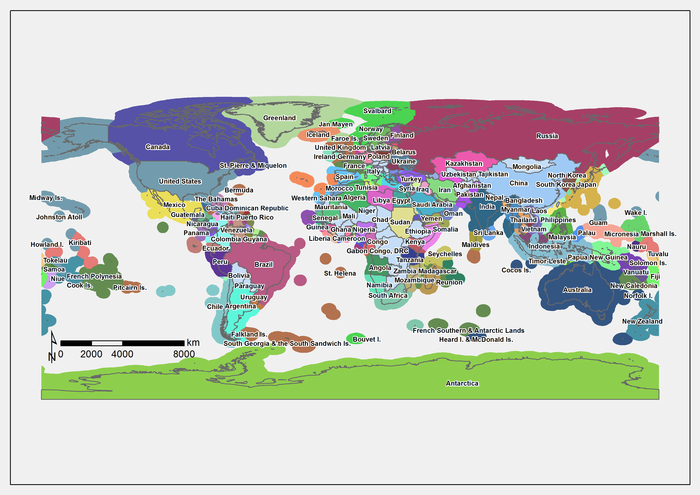
Main topics under regulation
IMO conventions and resolutions address a whole lot of topics. Some of the main ones are navigation, protection of the environment against pollution, trading, military operations, fishing and harvesting minerals.
The main source of legislation regarding navigation and in a more general view maritime safety is the International convention for the safety of life at sea (SOLAS, 1974). Two more conventions are also important in this field:
- the Convention on the International Regulations for Preventing Collisions at Sea (COLREG, 1972),
- the International Convention on Standards of Training, Certification and Watchkeeping for Seafarers (STCW, 1978).
Those conventions are regularly updated to include measures dealing with new kinds of vessels or the use of new technologies. SOLAS includes regulations for all the components of navigation: construction and stability of ships to avoid sinking even after damages to the hull, fire protection, life-saving appliances, radiocommunications, safety of navigation, carriage of cargoes and especially dangerous goods, special provisions for nuclear ships, high-speed vessels or bulk carriers, and measures to facilitate the identification and inspection of ships.
COLREG adds navigation rules (or “rules of the road”) to the previous ones in order to prevent collisions between vessels whereas STCW sets minimum qualification standards for merchant ships’ crew (officers, masters, watch personal), in terms of training, certification and watchkeeping.
In addition to that, IMO also issues guidelines on navigation issues and performance standards for shipborne equipment. Some of these guidelines have the same legal value as the conventions themselves.
Protection of the environment
Due to the importance of maritime shipping in world transportation and the risks it lays on the environment, the protection of the environment against pollution from any source is a major issue of maritime legislation. The following aspects are covered:
- pollution prevention: regulations are adopted in 1973 in the International Convention for the Prevention of Pollution from Ships (MARPOL). This convention addresses pollution by oil, liquid substances carried in bulk, harmful substances, sewage, garbage, and air pollution from ships discharge.
- pollution response: the International Convention on Oil Pollution Preparedness, Response and Co-operation (OPRC) established in 1990 is the major tool which provides a legal framework to help cooperation between countries in the response to major oil spills. It also requires states to develop their own systems for pollution response. The Protocol on Preparedness, Response and Co-operation to Pollution Incidents by Hazardous and Noxious Substances (OPRC-HNS, 2000) extends this framework to pollution caused by hazardous and toxic substances.
- ballast water management: ballast water can cause major threats to the ecosystems by moving species from some places to other ones in the world. Those species may become invasive in the host environment, compete with native species and trigger off their extinction, therefore causing threats to the ecological and economic system. The most relevant legislative tool to prevent a bad management of ballast water is the International Convention for the Control and Management of Ships’ Ballast Water and Sediments, adopted in 2004. This convention makes all ships prepare a ballast water and sediments management plan, to be approved by the IMO. For further details, see the article Ballast water.
- anti-fouling systems: the International Convention on the Control of Harmful Anti-fouling Systems on Ships was adopted in 2001 and prohibits the use of harmful substances that can act as biocides in anti-fouling paints or make ships bear a coating that forms a barrier to such compounds.
- recycling of ships: the International Convention for the Safe and Environmentally Sound Recycling of Ships was adopted in 2009. Its purpose is to make sure ships do not pose any risk to human health or the environment when they are in the process of being recycled after the end of their operational life. The convention is completed by guidelines to help states in the implementation of the technical standards.
Military operations
Most regulations regarding military operations in the sea are provided by UNCLOS, in its different chapter. In a general way, military vessels must comply with the same rules as merchant ships.[8]
Article 19 of UNCLOS introduces special rules for the navigation in territorial seas. Foreign military ships may only sail in those areas if their navigation can be considered as an “innocent passage”, that is a passage that may not harm the peaceful state and security of the coastal country. For military ships, this means that they can’t use any weapon against the coastal state, they can’t make exercises or manoeuvres involving the use of weapons, and they can’t board airplanes or military devices. Article 25 allows the coastal country to protect itself and take the necessary steps to prevent non-innocent passage.
In high seas on the contrary, every state has the right of free navigation, even for military vessels.
The situation is somewhat more complex in the exclusive economic zones, and UNCLOS has led to multiple interpretations of the rights to use the EEZ since its entry into force, some of them even worsen in international incidents (such as the USA – China Impeccable incident in 2009). According to article 58 of UNCLOS, other states have the right to use the EEZ for navigation and overflight purposes, as long as they have due regard to the rights and duties of the coastal state that are not incompatible with international agreements. Many maritime powers interpret this article by considering that naval operations are a form of ship operations and are therefore allowed by UNCLOS.
Fishing
Fishing in high seas is regulated through the Convention on Fishing and Conservation of Living Resources of the High Seas, established in 1958. This convention is designed to solve problems raised by the conservation of living resources of the high seas, and especially avoid the overexploitation of those resources. UNCLOS takes back some terms of this convention in its articles 116 to 120. All the states have the right to fish in high seas provided they comply with the terms of the convention, and in particular they take national measures and cooperate with other states to help conserve the living resources of the high seas and establish regional fisheries organizations to this end. To determine the allowable catch, states must take measures to maintain or restore populations of harvested species taking into account the interdependence of stocks. They must also carry out research and measurements to estimate the available fish stocks and exchange the results with other countries.
The convention is completed in some aspects by the United Nations fish stocks agreement in 1995 which sets out concrete principles for the conservation of fish stocks. The agreement provides a framework for the management of resources and promotes good order in the oceans. The food and agriculture organization of the United Nations developed on that matter with the Agreement to promote Compliance with International Conservation and Management Measures by Fishing Vessels on the High Seas and a Code of Conduct for Responsible Fisheries.
The Straddling Fish Stocks and Highly-Migratory Fish Stocks agreement[9] was adopted in 1995 by the United Nations to improve the management of fish stocks in regions which span wide areas and are of economic and environmental concern to several nations. Straddling stocks are defined as fish stocks that migrate through several exclusive economic zones. They are especially vulnerable to overexploitation.
Telecommunications
The main framework for the regulation of telecommunications through ocean cables is provided by UNCLOS. In its preamble, the convention insists on one of its purpose to “facilitate international communication”. This is repeated in numerous articles where special provisions are taken for submarine cables and pipelines.[10]
Since the operation of laying down a telecommunication cable can not be considered as an innocent passage in the sense of what is allowed in territorial seas, coastal states have the right to regulate the laying, maintenance and repair of submarine cables within those areas where they exercise their sovereignty.
Outside territorial seas however, the general rule is the freedom of use, and especially the freedom of laying down submarine cables and pipelines as stated in article 87 paragraph 1. Since there is no rule such as a national responsibility of a state over the high seas, the convention has an article dedicated to the protection of submarine cables. Each state must take laws and regulations to prevent ships flying its flag from cutting a cable, whether it is willful or an accident, or punish them in case the rules are broken.
The same rules applies to exclusive economic zones as long as the cable-laying ship pay due respect to the rights and duties of the coastal state. The laying of submarine cables on the continental shelf if authorized for foreign countries, but the coastal state may take reasonable measures relating to the exploration of its continental shelf and the exploitation of its natural resources which can put restrictions on the laying of the cables.
A coastal state keeps of course rights to impose conditions on cables which enter its territorial sea. Those conditions only apply to the parts of the cables inside the territorial seas.
Scientific exploration and research
The technological development of the last years and the always increasing demand on the marine environment led to an urging need to protect the sea from pollution and damages to the living and non-living resources. This involves of course a better knowledge of the underlying physical and biological processes which requires marine scientific research.[11]
According to part XIII of UNCLOS, all states have the right to conduct research programs on the high seas, provided this research is made only for peaceful purposes, with means compatible with the convention, and does not interfere with other legitimate use of the sea. UNCLOS also insists on the necessity to promote cooperation between states in the field of scientific research.
In the exclusive economic zones and on the continental shelf, coastal states may regulate scientific research. In particular, they can authorize or prohibit the access to the area to another state if the project has direct consequences on the exploitation of natural resources, or involves drilling into the continental shelf or the construction and use of artificial structures. Foreign states that want to conduct the research must describe accurately the work they want to carry out and the means and methods they will use, the geographical area in which the project will be conducted. They must also invite the coastal state to participate in the marine scientific research project and on board research vessels. All the reports and conclusions of the research must be sent to the coastal state if the latter asks for them, and an access to resulting data must be granted to it. If the foreign state does not comply with those provisions, the coastal state can order it to suspend its activities.
Foreign states may deploy and use scientific equipment in the framework of a research project, as long as they make sure those equipment do not hinder navigation.
See also
References
- ↑ Hugo Grotius. Mare liberum – The freedom of seas. Trans. from the Latin by Ralph van Deman Magoffin. Oxford University Press, 1916
- ↑ Cornelius van Bijnkershoek. De dominio maris dissertatio. Trans. from the Latin by Ralph van Deman Magoffin. Oxford University Press, 1923.
- ↑ United Nations convention on the law of the sea. United Nations, Dec. 10, 1982. URL: http://www.un.org/Depts/los/convention_agreements/texts/unclos/closindx.htm.
- ↑ International convention for the safety of life at sea. International maritime organization, Nov. 1, 1974.
- ↑ International ship and port security code. International maritime organization, Dec. 12, 2002.
- ↑ Convention on the international regulations for preventing collisions at sea. International maritime organization, Oct. 20, 1972. URL: https://en.wikisource.org/wiki/International_Regulations_for_Preventing_Collisions_at_Sea.
- ↑ International convention for the prevention of pollution from ships. International maritime organization, Feb. 17, 1973.
- ↑ Jing Geng. “The legality of foreign military activities in the exclusive economic zone under UNCLOS”. In: Merkourios. Utrecht journal of international and European law 28 (74 2012). Ed. by Utrecht publishing & archiving services Igitur, pp. 22-30. ISSN: 0927-460X.
- ↑ Agreement for the Implementation of the Provisions of the United Nations Convention on the Law of the Sea of 10 December 1982 relating to the Conservation and Management of Straddling Fish Stocks and Highly Migratory Fish Stocks. United Nations, Sept. 8, 1995. URL: http://daccess-ods.un.org/access.nsf/Get?Open&DS=A/CONF.164/37&Lang=E.
- ↑ Robert Beckman. “Submarine cables – A critically important but neglected area of the law of the sea”. In: 7th international conference on legal regimes of sea, air, space and Antarctica. (New Delhi, India, Jan. 15-17, 2010). Jan. 2010.
- ↑ Tim Daniel. “Legal aspects of marine scientific research and part XII of the UN convention on the Law of the Sea”. In: ABLOS Conference. (Monaco, Oct. 10-12, 2005). Oct. 2005.
Please note that others may also have edited the contents of this article.
|
